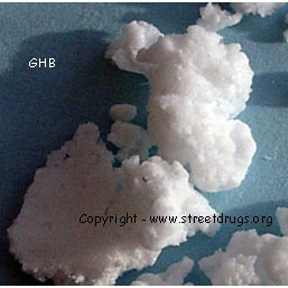
GHB (Gama Hydroxybutyric Acid) is a synthetic depressant produced in clandestine labs. While available as a prescription for sleep disorders in some other countries GHB was banned (in the U.S.) by the FDA in 1990 because of the dangers associated with its use. However, on July 17th, 2002, GHB was approved for treatment of a rare form of narcolepsy. Most of the GHB used in the U.S. is illegally manufactured within its borders. Like Rohypnol, GHB and its analogs are considered "date rape" drugs because they can be mixed with liquids (even water) and a victim wouldn't notice by smelling or looking at it. GHB, by itself, has a soapy or salty taste--but when mixed in a drink it may be difficult to detect.
Other products such as GBL and 1,4 butanediol (BD) are appearing in the illegal market as GHB substitutes. These analogs are just as dangerous and have similar effects on the body.
GHB can be made from ingredients such as GBL (gamma-butyrolactone), a solvent commonly used as a paint stripper, or butanediol (1,4-butanediol), a chemical used in the production of plastics and adhesives. Both GBL and butanediol are metabolized into GHB in the body. GHB, GBL, and butanediol (BD) are difficult to trace because they quickly leave the body and may be difficult to detect in emergency rooms and other treatment facilities. The FDA has issued warnings for both GBL and 1,4-butanediol, stating that the drugs have a potential for abuse and are a public health danger.
GHB and it's analogs are known as "G," "liquid x","caps," "scoop," "goop," "georgia home boy," and "grievous bodily harm."
GHB is a clear odorless liquid (usually mixed with alcohol) or a white powder (usually made into tablets or capsules.) GHB is snorted, smoked, or mixed into drinks. The most commonly abused form is the liquid.
On the street, it is usually sold as a liquid by the dose (a capful from a bottle or drops). In some cities, GHB is put into water guns, and users buy it by the squirt. In other instances, candy, such as a lollipop, is dipped in GHB and sold. Source: SAMHSA/CSAT, "GHB: A Club Drug to Watch."
Substance Abuse Treatment Advisory
EFFECTS OF USE:
The effects of GHB vary each time a person uses it and it affects each person differently. Initial effects include euphoria and relaxation. Within 15 minutes nausea, dizziness, drowsiness, visual disturbances, respiratory distress, amnesia, seizures, and coma are possible. It is difficult to predict a person's reaction to GHB-- because GHB is produced in clandestine labs, the purity and strength of doses vary. Coma, poisoning and death resulting from ingestion of GHB have been well documented. As of November 2000, DEA documented 71 GHB-related deaths.
Coma and seizures can occur following abuse of GHB and, when combined with methamphetamine, there appears to be an increased risk of seizure. Combining use with other drugs such as alcohol can result in nausea and difficulty breathing. GHB may also produce withdrawal effects, including insomnia, anxiety, tremors, and sweating. Because of concern about Rohypnol, GHB, and other similarly abused sedative-hypnotics, Congress passed the "Drug-Induced Rape Prevention and Punishment Act of 1996" in October 1996. This legislation increased Federal penalties for use of any controlled substance to aid in sexual assault.
Source: "Rohypnol and GHB," NIDA InfoFacts, #13556